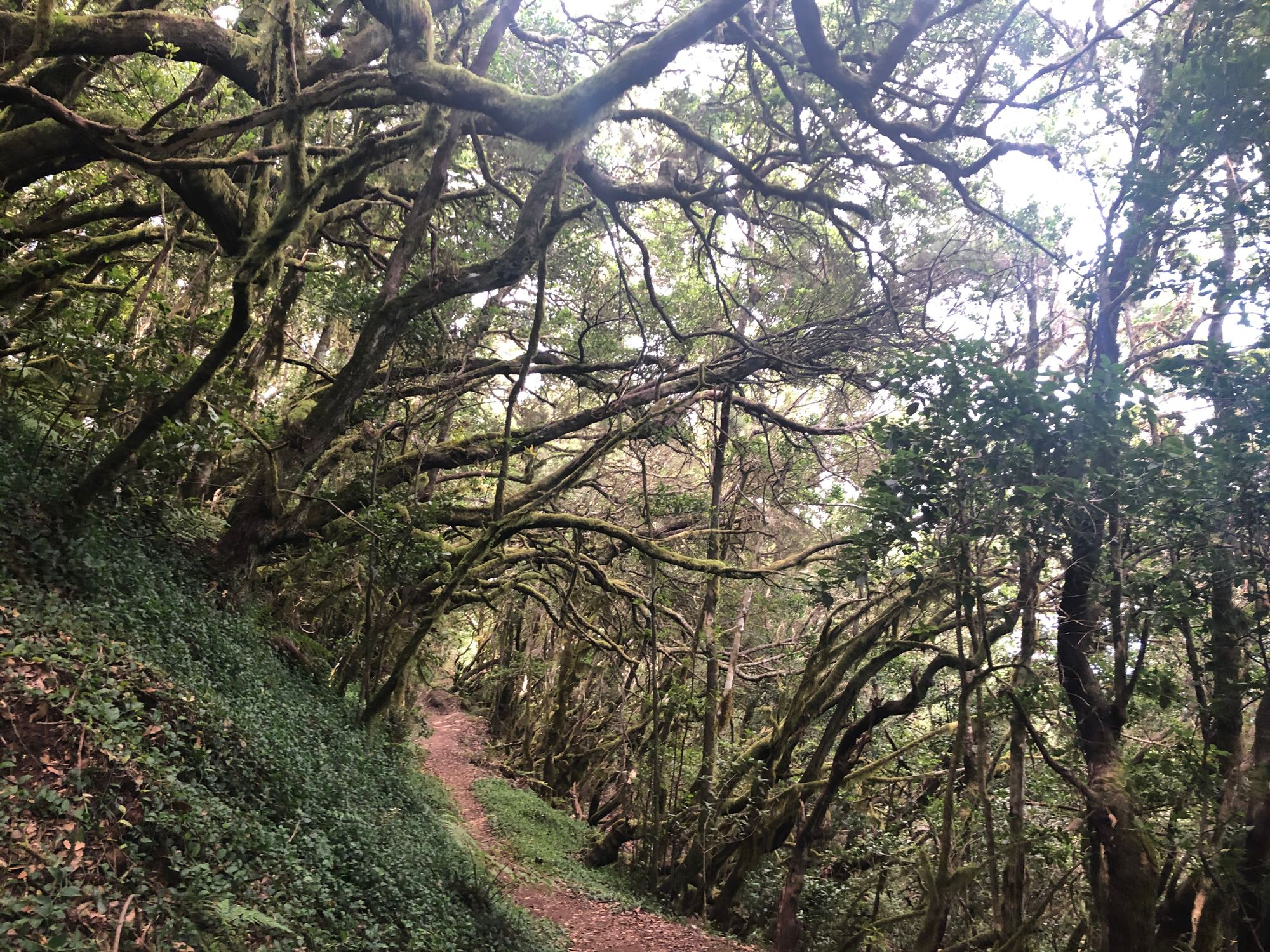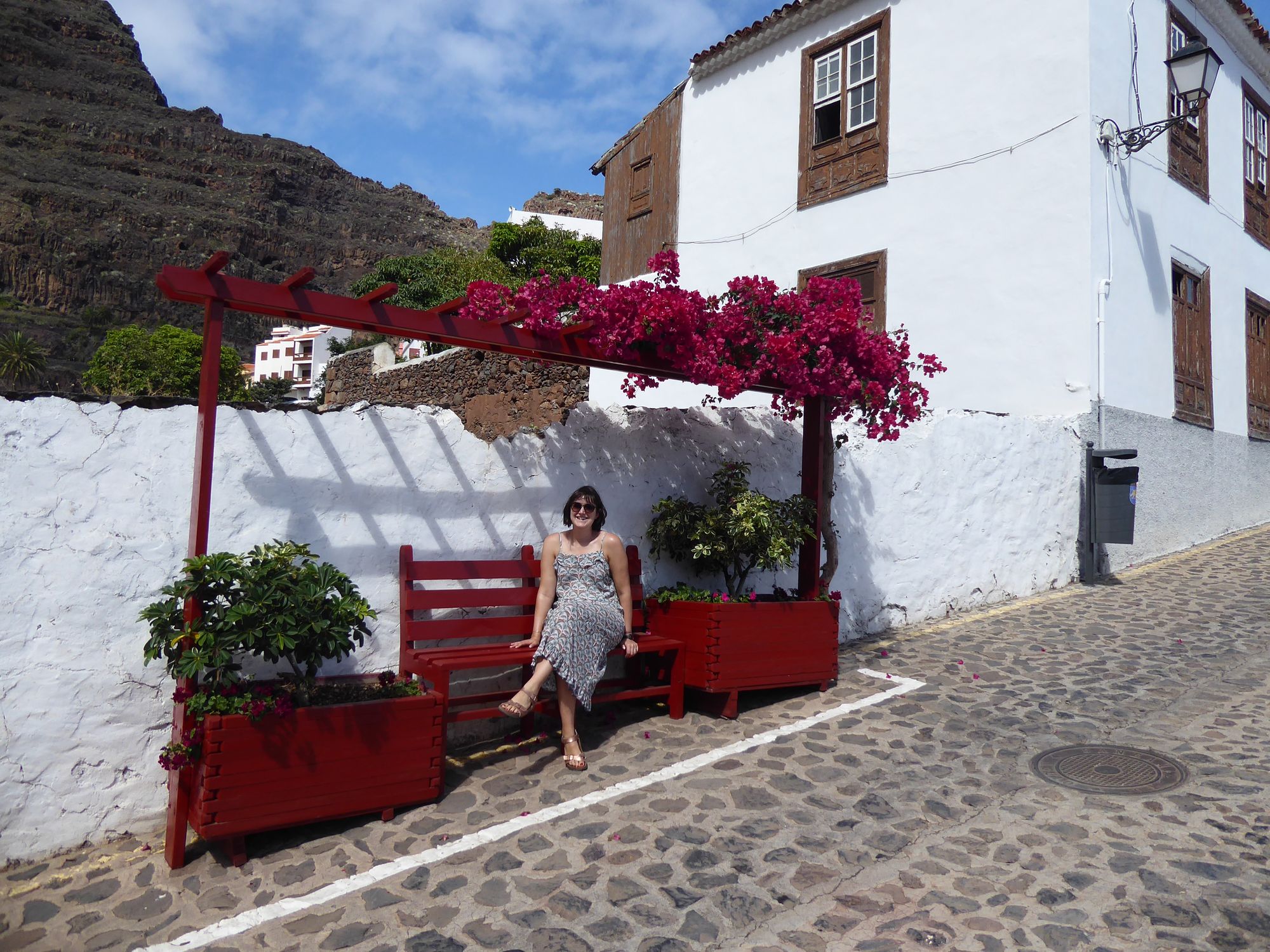The fragile forests of La Gomera

Flat surfaces are hard to come by on La Gomera.
This pint-sized volcanic isle, the second smallest of the Canary Islands, is shaped like a lemon squeezer, with mountainous spurs radiating out from the centre and deep valleys plunging towards the coast. To get anywhere on the island you usually have to drive up into the central highlands, then back down to your destination, and the uphill stretches were a constant struggle for our underpowered hire car.
We wound our way up and up along endlessly curving roads, through a landscape of almost desert severity: brown and dry, dotted with scrubby vegetation. But when we eventually reached the top, the view changed dramatically.
Suddenly we were enveloped in green, with trees closing in above us and an eerie mist drifting across the road. We were in the midst of the laurisilva, La Gomera's crown of lush laurel forest, one of the few remaining examples of an ancient ecosystem that once covered much of the Mediterranean and North Africa. The fact that such a forest can exist in a place where it rarely rains is down to La Gomera's unique geography, exposed to trade winds blowing in off the Atlantic. The top of the island is often swathed in cloud and the forest traps the moisture, which then percolates down through the ground and provides much-needed water to the rest of the island.

La Gomera's Garajonay National Park, a UNESCO World Heritage Site, is the most pristine example of a laurisilva forest in the Canaries, and there are a number of hiking trails that criss-cross the park. We opted for trail 14, a circular six-mile hike that takes you from the visitors' centre at Laguna Grande up to Alto Garajonay, the highest point on the island. We set off down a path that initially took us through a shady part of the forest, with butterflies flitting about and the occasional electric blue dragonfly buzzing overhead. Little birds zipped between low bushes, and the foliage protected us from the fierce sun. But this idyllic scene didn't last very long.
In August 2012 a devastating wildfire ripped through the forest and 800 hectares went up in flames, almost 20% of the National Park. We knew that we would be hiking through an area affected by the fire, but we hadn't realised just how much of the trail had been stripped of its tree cover. We were soon sweating our way along a baking, dusty path exposed to the full glare of the sun, flanked on either side by blackened tree stumps. Nature has started to repair itself, with greenery sprouting from the ashes, but it will take decades for the forest to fully recover. And the biggest worry, of course, is another fire. Climate change is fuelling an increase in the frequency and ferocity of wildfires worldwide, including in the Canary Islands; just this year, a huge fire in Gran Canaria led to the evacuation of thousands of people.

It took us two hours to reach Alto Garajonay, and from the top we could see the dense white cloud layered over the forest, along with the neighbouring islands of Tenerife, La Palma and El Hierro shimmering in the distance. We could also see how badly the landscape had been ravaged by the wildfire.
We found a shady spot to wolf down a couple of bocadillos for lunch, then made the much easier descent down a different track back to Laguna Grande. The forest was in better shape along this path, but we still saw plenty of fire damage. We joked about how we'd brought our jumpers and waterproof coats, after reading about the mists that float through the forest and 'chill you to your bones'; instead we were hot, sweaty and covered in dust.

The Spanish colonised the Canary Islands in the 15th century, not long before they set out to conquer the Americas. In the century that followed the subjugation of La Gomera's native Guanche population, forest cover on the island was reduced by around 65%. Many settlers tried to eke out a living on La Gomera by farming, and the island's hillsides are still scarred with terraces, the only way of growing food on this unforgiving terrain. Building them must have been backbreaking work, and making a living here was tough. From the 18th century onwards many Gomerans emigrated to South America and the Caribbean in search of a better life, and their farms now lie abandoned.

The area around Playa Santiago is typical of the 'badlands' on the parched south side of La Gomera, where much of the terrain lies empty and barren. Some locals are campaigning to restore native forest to this part of the island, to try and reverse the damage done to the land by farming and climate change, but there was precious little shade as we set out on a walk along the coast. The only plants we saw were grey-brown grasses, skeletal shrubs and bulbous spurges, and we had cleverly managed to time our walk to coincide with the hottest part of the day. Our stroll quickly turned into quite a strenuous yomp over hilly terrain, with the occasional sea breeze providing the only relief from the sun.
We dipped our feet in the water at Playa del Medio, a grey-black beach where the waves rattled the pebbles and pumice. A couple of German hippies were swimming naked in the sea, but otherwise the beach was more or less deserted. Out on the water, a solitary boat phut-phut-phutted across the bay. La Gomera is full of places like this, wild and empty.

In the north of the island, the landscape changes again. Once again we drove up into the laurisilva and out the other side, the road narrowing and wriggling its way towards the north east coast. We stopped at a viewpoint where the Hermigua valley was laid out in front of us, a green carpet of banana plantations stretching all the way to the sea. Yellow and white houses clung to the terraced valley sides, their gardens overflowing with bright bursts of bougainvillea.

We parked opposite Hermigua town hall, loaded up on bocadillos once more and set off on trail 37, another circular hike. This walk would be a bit longer than Alto Garajonay at nine miles long, but it was the elevation gain that I should have paid more attention to. Immediately we found ourselves huffing and puffing up endless concrete steps, weaving in and out of the houses on the steep west side of the valley. After a while we left the town behind and the steps turned into a rough mountain track, still endlessly climbing, and with barely any shade.
The first two miles took us two hours, even with the bamboo poles that we fashioned into makeshift walking sticks. We stopped frequently to get our breath back, to admire the spectacular views of the valley and to have a closer look at the eccentric array of succulents, aloes and prickly pears growing along the trail. Once again the silhouette of Tenerife and the towering, snow-capped Mount Teide hovered on the horizon.

Eventually the trail flattened out and we found ourselves back in Garajonay National Park, enjoying a gentle downhill stretch through cool and shadowy laurel forest. Gnarled trees coated in lichens loomed over us like something from The Lord of the Rings, and everywhere we saw rusty orange butterflies.
After a snack stop at Los Aceviños we found ourselves struggling uphill once more, on a rough path hacked out of the forest floor. The trail didn't seem well used, and we had to push through ferns and thorns. We stopped for lunch at El Cedro, then began a punishing descent down yet more steps, slippery and uneven in places, alongside a gushing stream. Down and down, past a dam and sloshing pipes transporting the precious water to other parts of the island. The vegetation became more tropical in appearance, with palms and tall thickets of bamboo.

By the time we got back to the car our legs were tired and our feet were sore. The hike had taken us about 6½ hours including stops, and my calves were still aching days later.
Our week in La Gomera was drawing to a close when we drove through the laurisilva for the final time, back to the north of the island.
Up here is the pretty village of Agulo, which squats on the coast at the foot of sheer-sided mountains. The sleepy streets were full of beautiful 18th and 19th century Canarian architecture, and old women congregated on street corners like teenagers, shouting and laughing in an impenetrable dialect. Banana leaves rustled in the wind, and somewhere a goat bleated plaintively.

Just across the water was Tenerife, the clustered white apartments and hotels and timeshares more clearly visible in the haze than they had been all week. All too soon the ferry would be taking us back to that other world, so far removed from the seductive simplicity of life on La Gomera.

